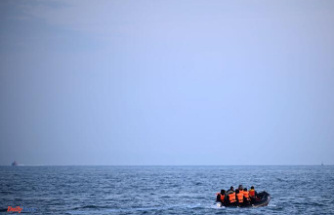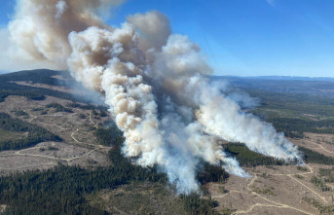Ninety-sixty-ninety. Sounds attractive, but in this case it means the unattractive key figures of the way to the Mani. If you get on the bus in Kalamata, you get off 90 curves, 60 curses and 90 signs of the cross later in Kardamili. The hot-headed bus driver at the steering wheel is responsible for loud cursing. Its passengers take it upon themselves not only to fervently cross themselves before particularly tricky bends, but at all churches, chapels and accident sites that are on the bus route.
Visitors can only count curves, curses and signs of the cross and let themselves shake dizzily. They will be richly rewarded for this on the last hill before Kardamili: the panorama of the maniotic landscape spreads out in front of the bus window.
The picture is framed by the Taygetos Mountains on the left, the Messenian Gulf on the right, and hills covered with olive groves and green-brown macchia undulating between the mountains and the sea. Far in the distance, milky blue mountain ranges mark the southernmost tip of mainland Greece. Not too many tourists make their way here.
It's the land of the Maniots, a community said to descend directly from the Spartans, the legendary warriors of ancient Greece who liked to leave their infants out overnight to harden them. Today the Spartans only appear in the tales of the tour guides who accompany you through the Virou Gorge, for example. It is the most monumental natural setting on the entire peninsula. In winter, the powerful Virou flows through it, in summer you can hike through the dry river bed from Kardamili.
In any case, the entire Mani can be discovered on foot. A widely ramified network of old donkey paths complements the well-developed but sparsely signposted hiking routes. They lead through a unique landscape that has been sculpted by the sea, wind and weather for thousands of years, giving the Mani its brittle face.
When it comes to the history of the origins of their country, the locals report less frequently about the forces of erosion, but all the more frequently about a truly divine throw: When God created the world, they say, he is said to have had a handful of stones left over. He simply threw it behind him – and the mani was done.
However, the Maniots wanted nothing to do with the creator of their region until well into the 9th century AD. The many Byzantine churches, chapels and caves that hermits dug into the rocky slopes testify to how successful Christianization was in the end.
At another point in the Mani, it goes very deep down and then directly into Hades, into the realm of the dead. The entrance to the underworld is said to be at the small bay of Marmari. Orpheus once descended there to look for his Eurydice.
Less than three kilometers further you reach the lighthouse at Cape Tenaro and the area around Porto Kagio, a breeding ground for quail, storks and many migratory birds from northern Europe. The hilltops become more and more bare and rugged the further south you go, the so-called inner Mani. Only thistles and cacti add green splashes of color here and there.
Nevertheless, a few travelers, lured by the promise of finding one of the most beautiful stalactite caves in Europe in nearby Pirgos Dirou, make it to the city of Areopolis, named after the god of war Ares. A punt driver silently punts visitors through the subterranean passages, halls and tunnels of Glyfada Cave, past vast forests of stalagmites and galleries of low-hanging stalactites, some needle-thin, others as thick as tree trunks.
The Mani does not offer any other classic attractions, which protects it from tourist crowds. There are pure sandy beaches that shape our idea of a holiday in Greece, but there are only a few. One of the most popular is the golden beach of Kalogria, which few people know was the stage for a piece of world literature.
"We were in a hurry for the sun to go down so we could both sit down on the beach, eat our tasty farmer's meal, sip our bitter red wine and start the conversation." That's how Nikos Kazantzakis describes his evenings he spends with his friend Zorbas in Kalogria spent.
Above the bay, the two tried to operate a lignite mine because Kazantzakis had taken it into his head that he had to swap the ivory tower of the learned writer for the rough life of a worker. What became of this project and the two men is world-famous, made famous by Kazantzakis' novel "Alexis Sorbas". The story is completely true, but Kazantzakis changed the setting of the action, choosing Crete instead of Mani as the setting for the mining adventure.
The Mani doesn't seem to be particularly proud of the two celebrities. Only a bronze bust above Kalogria Bay is reminiscent of Kazantzakis. It's not to say that the Maniots were too unhappy about the story being moved to Crete.
Because Zorbas also tells of unflattering experiences such as lynch law, scavenging and suicide. For his part, Kazantzakis may have concealed the true location of events in order to avoid trouble with the Maniots, who were and are considered to be particularly irascible and resentful.
The high residential and defensive towers of former family clans, which one comes across again and again on hikes through the Mani, are a reminder of their notorious lust for battle and revenge. In the 17th and 18th centuries, curses, stones, hot oil, rifle and cannonballs flew from these bulwarks to ward off foreign invaders or to settle feuds with feuding families.
Today, many defense towers have been converted into hotels or guesthouses. They are usually equipped with several balconies and terraces so that guests can enjoy both the unobstructed view of the Messenian Gulf and the mountains.
It doesn't need more - mountains and sea, maybe a few pickled Kalamata olives, plus a little cricket serenade and a gentle wind that sends the heat of the day into the end of the day. Or to put it in Nikos Kazantzakis' words: "All you need to experience happiness in the here and now is a simple, frugal heart."
Do we have! Next time, however, our frugal hearts would rather travel by rental car and not by bus. That's zero eight fifteen, but much easier on the stomach and nerves.
Arrival: In the summer months directly to Kalamata with Condor or Eurowings, otherwise flight to Athens and then by bus (ktelmessinias.gr) or rental car to the Mani (about four hours travel time).
Accommodation: In the fishing village of Agios Nikolaos, the "Mani Villas" offer apartments with a view of the Messenian Gulf and the Taygetos Mountains, from 80 euros for two guests, bookable via wundertravel.com. Beautifully located holiday homes/apartments in the Mani can also be found with these providers: skafidakia.gr, stoupa-properties.gr, zorbas.de, nikoloudiestate.gr.
More information: visitgreece.gr
In the middle of the holiday season, chaos reigns not only at German airports. In Spain and France, many flights were canceled or landed late due to strikes and staff shortages. Affected travelers have certain rights in such cases.
Source: WELT/ Antje Diedrichs












